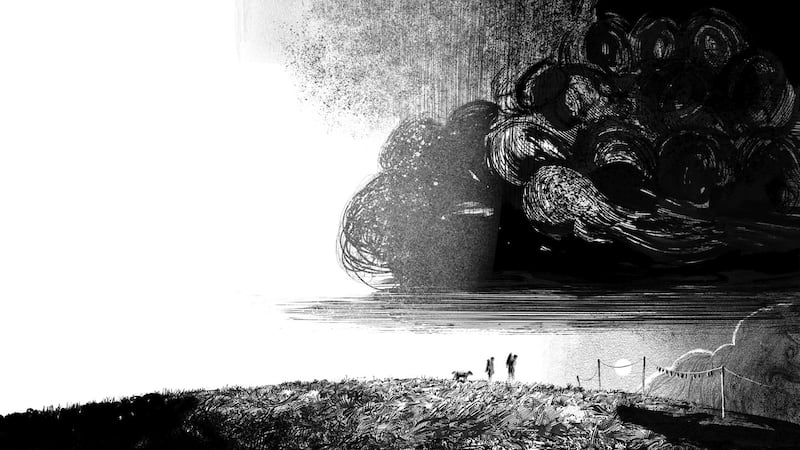“There was no fairy at my crib. I think that when I opened my eyes I suddenly saw my whole life in front of me: a stone wall, bars over my eyes, a gag in my mouth, and metal in my heart.”
Seventeen-year-old Eve moves through the world doing what is needed to survive. In her best friend Savita, she finds joy and solace, but more often than not she trades part of herself with men: “morsels, bits, various parts of my body . . . I am in permanent negotiation. My body is a stopover. Entire sections have been explored. Over time, they blossom with burns and cracks. Everyone leaves some trace, marks his territory.”
Ananda Devi is an award-winning, prolific author (she has published more than 20 books, ranging from novels to short story collections and poetry), writing in French and drawing on a variety of cultures, including her childhood in Mauritius. Eve Out of Her Ruins (Les Fugitives, £7.99), translated by Jeffrey Zuckerman, is set there, and paints an unflinching but poetic portrait of this island nation in the Indian Ocean, east of Madagascar.
We are likely to think of Mauritius as a tourist destination, which it is, or where the dodo once lived; Devi focuses on the lives of four teenagers who have grown up there, in poverty, and who understand the rules of the cité, the ghetto. Here “a children’s playground has become a battleground teeming with needles, shards of broken glass, hopes snaking into nothing”.
This edition of the novel is particularly aimed at raising awareness of literary fiction in translation among young people, and a new preface from Devi explains her intention is writing for – not just about – all disenfranchised youth, those for whom violence is “the resistance of the hopeless”.
This all sounds terribly grim and “worthy”, but there’s a careful balance between beauty and despair, not just in the carefully crafted sentences but in the content. The depiction of the commodification of female sexuality is nuanced and haunting, never gratuitously bleak or polemical. In a storyline that involves a murder, a wrongful arrest, a riot and revenge, there’s space for love, for poetry, for hope. That Devi (and Zuckerman) get all of this into less than 200 pages is remarkable.
It is both a cliche and yet still necessary to note that young adult fiction would benefit from more work in translation; as well as being a simply gorgeous book in its own right, Eve Out of Her Ruins draws attention to how often the field is shaped by American culture and norms.
And now for precisely one of those books – Nicola Yoon's Instructions for Dancing (Penguin, £7.99) takes place in Los Angeles, source of the Hollywood movies that teach so much of the world what to expect from life and love. It's Yoon's third novel, and with both her previous titles having been adapted for film, one senses her leaning into this mode – this tale of a girl falling in love with her competition dance partner seems made for the screen.
There are times when the prose offers up tiny snapshots, attempting to capture the feeling of a montage; it sometimes succeeds but falls a little short when it comes to conveying the excitement and intimacy of dance sequences. It is also – despite the narrator’s sassy analysis of romantic tropes, gleaned from the novels she’s since cleared out, now that her parents have split up and she no longer believes in love – predictable, plot-wise, down to a twist that may shock some but is in many ways the obvious outcome. But no intelligent reader picks up a romance title imagining that the ending will shock them, in the same way no one picks up a murder mystery anticipating that there will still be a question mark over the killer’s identity by the last page.
Instructions for Dancing satisfies as a romance and a tear-jerker; it’s a book that tells you “given enough time, all love stories turn into heartbreak stories” and then convinces you that it’s worth it all the same.
Alice Oseman's Loveless (HarperCollins, £7.99) deserves a mention for being a love story that includes but doesn't exclusively focus on romantic entanglements. This account of a first year at university sees narrator Georgia realise she's both asexual and aromantic, or "aro/ace". (She is self-aware to know that these identities do sound a bit niche and only relevant to internet subcultures, while the novel is sufficiently immersed in youth culture to demonstrate how useful such labels can be to explain not wanting the allegedly "normal" things in life.)
Loveless is an ode to friendship and platonic soulmates; this cosy blanket of a novel understandably won the YA Book Prize last month.
"I wanted to be a person who had so much integrity that they wouldn't spend it, but integrity is for people with other income streams," 16-year-old Aideen reflects in Not My Problem (Andersen Press, £7.99), the second novel – and second relatable, witty protagonist – from Ciara Smyth. Aideen casts a sharp eye over her own circumstances ("I get all my cardio from anxiety about what my mother is doing at any given moment"), only occasionally letting herself be honest about how poverty feels "like some kind of moral failing".
Her desire to protect her mother and herself from formal intervention lurks in the shadows throughout this entertaining, hijinks-filled novel about swapping favours and solving other people’s problems, as well as a crush on the highly-strung Maebh (the sort of girl “who will either run the world or become a supervillain dedicated to destroying it”). I utterly adored it.


What it means to be a teenager with an unstable parent, shifting between dependent and protector from day to day, is also explored in We Were Wolves (Andersen Press, £12.99), a beautifully strange illustrated novel by Jason Cockcroft (known already for his picture books and extensive illustration work). The unnamed narrator loves his father fiercely, and is the only one who can soothe him when he experiences traumatic flashbacks from his time as a soldier.
“Times like this he looked indestructible, some warrior from one of his books, half forest, half man. He might have been a hunter back in the days of stag and bear, lost in the cage of trees but free, too, living as wild as them. Times like these, I’d forget the nights when he’d been cowering in Mam’s backyard, and sobbing, like it was another man. And that was our mistake, because he was all of it at once – warrior and soldier and crying lad. And criminal.”
Living in a caravan in the woods of Yorkshire, the protagonist is relatively happy to be disconnected from the world of school with its bullies and homework, but less content to be pulled into his father’s criminal activities. All the while there is something looming in the darkness, ready to pounce; the shadowy illustrations remind us of beasts lurking under the soil, and the fine line between myth and reality.
This powerful yet unsentimental novel calls to mind the work of Patrick Ness and David Almond, and their capacity to be both topical and timeless.




















